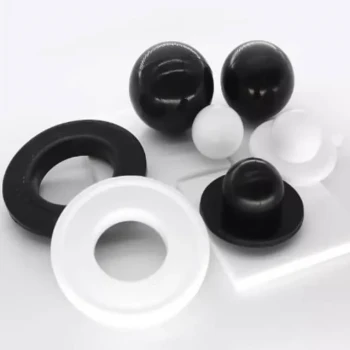The primary function of a PTFE lined spacer is to create a durable, low-friction, and chemically inert barrier between mechanical components. It actively reduces friction and wear, prevents corrosion, and provides a reliable seal, far exceeding the simple role of a standard spacer.
While a basic spacer merely creates distance, a PTFE lined spacer is an engineered solution for demanding environments. Its value comes from the unique properties of Polytetrafluoroethylene (PTFE), which actively reduce wear, resist chemical attack, and ensure operational integrity where other materials would fail.

The Core Principle: Why PTFE Lining Matters
The effectiveness of this component is not in its shape, but in the material properties of its Polytetrafluoroethylene (PTFE) lining. Understanding these properties reveals why it is specified for critical applications.
Exceptionally Low Friction
PTFE, commonly known by the brand name Teflon, has one of the lowest coefficients of friction of any solid material. This creates an incredibly smooth, non-stick surface.
This characteristic directly minimizes the energy required for movement and drastically reduces wear between sliding or rotating parts.
Superior Chemical Resistance
PTFE is almost completely inert and does not react with most acids, alkalis, and corrosive chemicals.
This makes PTFE lined spacers essential in equipment that handles aggressive media, such as chemical processing pumps and valves, where a standard metal or plastic spacer would quickly corrode and fail.
High Thermal Stability
The material maintains its structural integrity and performance characteristics across a very wide temperature range.
Unlike many plastics that can become brittle at low temperatures or deform at high temperatures, PTFE remains stable, ensuring consistent performance in challenging thermal environments.
Excellent Sealing and Isolation
The non-stick surface of PTFE prevents media buildup and ensures a clean, effective seal.
In applications like flange connections, the spacer not only provides correct spacing but also acts as a gasket, preventing leaks and isolating components from electrical currents or corrosive fluids.
Common Applications and Use Cases
The unique combination of these properties makes PTFE lined spacers versatile components in several key industries.
Automotive and Machinery
In automotive assemblies and industrial machinery, these spacers are used in rotating shafts, pivot points, and sliding mechanisms. They reduce the need for lubrication, extend the lifespan of moving parts, and lower maintenance requirements.
Chemical Processing
PTFE lined components are standard in chemical dosing systems, pipelines, and reactors. A spacer used in a flange or valve must resist the highly corrosive media, and PTFE is often the only material that can provide long-term reliability.
Manufacturing and Automation
In high-speed manufacturing equipment, reliability is paramount. PTFE spacers ensure smooth, repeatable motion in automated systems, preventing the seizure or galling of components and minimizing production downtime.
Understanding the Trade-offs
While highly effective, PTFE lined spacers are not a universal solution. Acknowledging their limitations is key to proper application.
Susceptibility to Creep
PTFE is a relatively soft material and can be subject to "creep" or cold flow. Under a high, sustained compressive load, it may slowly deform over time. This must be accounted for in high-pressure mechanical designs.
Lower Mechanical Strength
Compared to a solid metal spacer, a PTFE lined component has lower compressive strength. It is not designed for applications where the primary function is to bear extreme structural loads.
Higher Initial Cost
As a high-performance engineered polymer, PTFE is more expensive than common plastics or standard metals. The cost is justified by its extended lifespan and reliability in environments where other materials are unsuitable.
Making the Right Choice for Your Application
To determine if a PTFE lined spacer is the correct component, evaluate your primary engineering goal.
- If your primary focus is reducing mechanical wear in a moving assembly: The spacer's ultra-low friction is its key benefit, acting as a permanent dry lubricant to extend component life.
- If your primary focus is performance in a corrosive environment: The spacer's chemical inertness is paramount, ensuring it will not degrade, contaminate your system, or fail prematurely.
- If your primary focus is reliability across a wide temperature range: The spacer's thermal stability ensures it maintains its shape and properties where other materials would warp or crack.
Ultimately, selecting a PTFE lined spacer is a deliberate choice for long-term reliability in challenging operational conditions.
Summary Table:
| Key Function | Primary Benefit | Ideal For |
|---|---|---|
| Low Friction Barrier | Reduces wear & extends component life | Moving assemblies, rotating shafts |
| Chemical Resistance | Withstands acids, alkalis, & corrosive media | Chemical processing, valves, pumps |
| Thermal Stability | Maintains performance across wide temperature ranges | High/low-temperature environments |
| Effective Sealing | Prevents leaks & isolates components | Flange connections, gasketing applications |
Need a reliable solution for your demanding application?
At KINTEK, we specialize in manufacturing high-precision PTFE components, including custom PTFE lined spacers, seals, liners, and labware. Whether you require prototypes or high-volume orders, our expertise ensures a component that delivers superior chemical resistance, low friction, and long-term reliability for the semiconductor, medical, laboratory, and industrial sectors.
Let's engineer the perfect spacer for your needs. Contact our team today for a consultation!
Visual Guide

Related Products
- Custom PTFE Parts Manufacturer for Teflon Containers and Components
- Custom PTFE Parts Manufacturer for Teflon Parts and PTFE Tweezers
- Custom PTFE Measuring Cylinders for Advanced Scientific and Industrial Applications
- Custom PTFE Teflon Balls for Advanced Industrial Applications
- Custom PTFE Sleeves and Hollow Rods for Advanced Applications
People Also Ask
- What is the hardness range of PTFE on the Shore D scale? Leveraging Its Softness for Superior Performance
- How does PTFE compare to other low-friction plastics like UHMW-PE and Nylon? A Guide to Material Selection
- Why is PTFE considered a significant discovery? A Material That Revolutionized Industry
- What are some applications of CNC machined PTFE parts? Critical Components for Medical, Electrical & Food Industries
- When and by whom was PTFE discovered? A Tale of Accidental Innovation



















